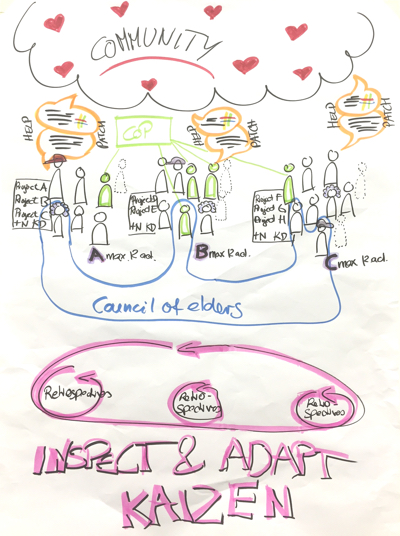A new team structure for the Neos Project
– Written by Tobias Gruber
Gina Steiner presented a suggestion for an agile project organization structure based on prior workshops together with a couple of the team members on the first day of the sprint. A workshop followed which was quite different from a normal “sprint” day. Together we discussed and specified the project structure for the Neos Project including teams, roles, communities of practice and a “council of elders”. An initial draft for guidelines and descriptions for the different roles and groups was created to get an understanding of how we will work within this new structure.
Our new structure

Enter caption here
The developed agile structure was put to the vote on Tuesday and received 19 “yes” and 3 “abstained” votes.
Teams
In the new structure the Neos Project will strive to create three cross-functional teams. Each team should consist of at least six members (but not more than twelve) and have the skills required to perform projects autonomously. These teams will decide which projects, tasks and ongoing activities they work on by pulling them from the backlog.
Two roles will be voted once a year in each team amongst the members: a synchronizer and a prioritizer. The synchronizers are responsible to meet amongst themselves regularly, search and care for new team members and moderate the team activities. The prioritizers meet amongst themselves regularly, prioritize the global backlog, pull projects for their team and manage the execution of pulled projects.
Communities of Practice
Layered over the teams will be CoPs (communities of practice). These groups form across the teams by personal interest to focus expertise in a certain area. They can include members from the community. The main goal of the CoPs is to set standards for the Neos Project in their specific area, do experiments and create projects for the teams to work on.
“Council of Elders”
The council of elders is a group of 12 members at most which defines the vision of the whole project and guides its true north, the fundamental assumptions and aspirations of the project. One becomes a member of the council by merit but must be an active team member. The council is also the last authority for the project, pulled in to resolve any conflicts with an unanimous vote.
All the details about the working draft of the new structure can be found on Discuss, your feedback is welcome.
Why change the structure?
On the one hand the Neos team has to perform many more activities like infrastructure management, marketing or funding since the separation from the TYPO3 Association. On the other hand there are a number of limitations with the current structure that the team wants to overcome. See the workshop results for more details.
The goal of the new structure is to be more scalable, create accountability for task completion and make the projects organization more transparent for the community and contributors.
Next steps
A collection of potential team candidates will be created and contacted to see if those candidates are interested in joining and to interview them to prepare for a team forming event where all interested candidates will self-organize into teams. This is scheduled within the coming weeks.
A task force has been created to ensure and help the transition process to the new structure consisting of Aske Ertmann, Ben Van Kruistum, Christian Müller, Dominique Feyer & Gina Steiner. The process can be followed in Jira and in the #cop-transition channel on Slack.